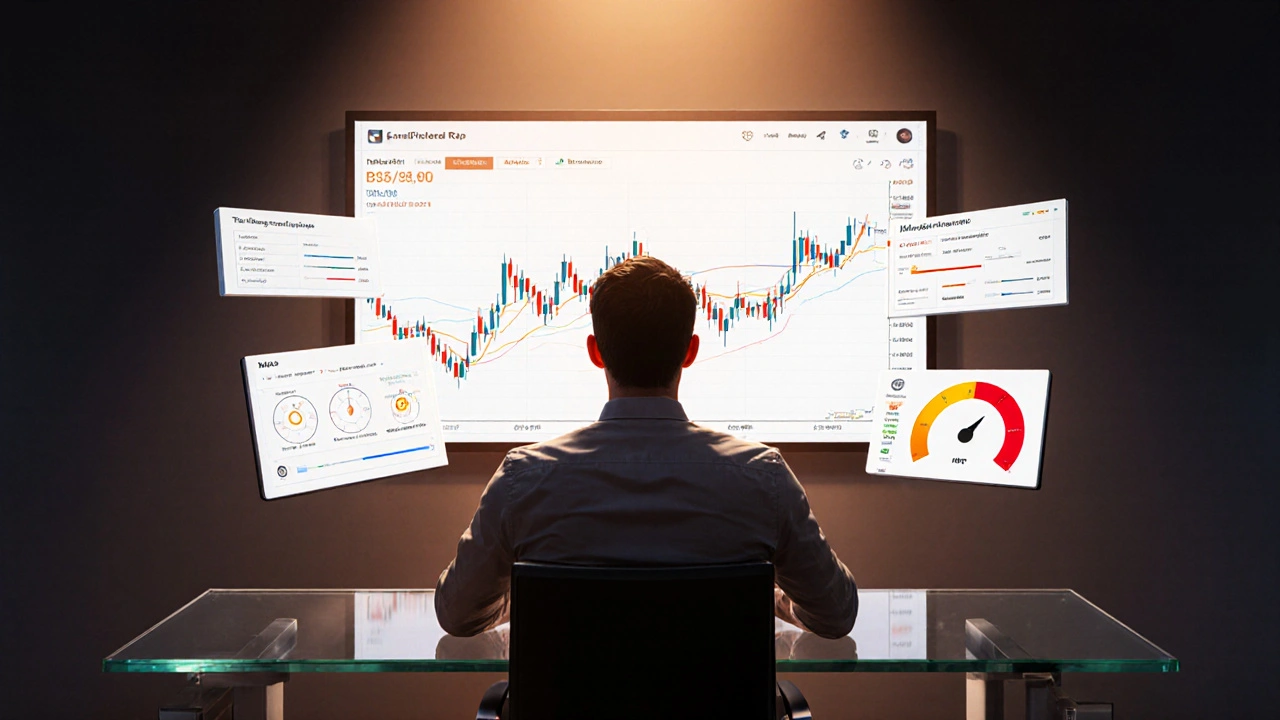Understanding the Core Idea
When you hear the term perpetual swap, think of a futures contract that never expires. Unlike a traditional futures contract, which has a set settlement date, a perpetual swap rolls on indefinitely. This design lets traders keep positions open as long as they can meet the margin requirements, making it a favorite in the crypto‑derivatives space.
Perpetual Swap is a type of derivative product that mirrors the price of an underlying cryptocurrency while offering leverage and a built‑in funding mechanism to keep its price tethered to the spot market. The product originated on centralized exchanges like BitMEX in 2016 and quickly spread to newer platforms such as Binance, Bybit, and Kraken.
How It Differs From Classic Futures
Traditional futures have three key features that set them apart:
- Fixed expiration date (e.g., September 2025).
- Daily settlement or final cash‑settlement at expiry.
- Often limited leverage compared to crypto‑specific products.
Perpetual swaps drop the first two items. Instead of a calendar‑driven expiry, they employ a Funding Rate - a periodic payment exchanged between long and short positions. When the perpetual price trades above the spot price, longs pay shorts; when it trades below, shorts pay longs. This continuous balancing act keeps the contract price aligned with the underlying market.
Key Components You Need to Know
- Leverage - The multiplier that lets you control a larger position with a smaller amount of capital. Typical ranges are 5x‑100x on crypto exchanges.
- Margin - The collateral you deposit to open a leveraged trade. It can be in the form of the quote asset (e.g., USDT) or the base crypto.
- Liquidation - The forced closing of a position when margin falls below the maintenance threshold. Exchanges usually liquidate at a pre‑set price to protect the system’s solvency.
- Open Interest - The total number of outstanding contracts, useful for gauging market sentiment.
- Funding Timestamp - Typically every 8 hours (e.g., 00:00, 08:00, 16:00 UTC) when the funding payment is calculated.
Why Traders Love Perpetual Swaps
Flexibility is the headline. Because there’s no expiry, you can ride a trend for weeks or months without worrying about rolling over contracts. The funding mechanism creates a natural arbitrage opportunity: if you can predict the direction of the funding rate, you can lock in a small, recurring profit regardless of price movement.
Leverage amplifies both gains and losses, so risk management becomes crucial. Experienced traders use tight stop‑loss orders, monitor the funding rate, and keep an eye on liquidation thresholds.

Risks You Can’t Ignore
High leverage can wipe you out fast. A 1% adverse move on a 50x leveraged long position erases your entire margin. Additionally, funding payments can flip from positive to negative in a single interval, turning a net payer into a net receiver overnight.
Liquidity risk matters on smaller exchanges. If the order book is thin, a large market order can cause slippage, pushing your entry price into an unfavourable range. Always check the Open Interest and depth charts before committing sizable capital.
Popular Platforms Offering Perpetual Swaps
| Feature | Perpetual Swap | Traditional Futures | Spot Market |
|---|---|---|---|
| Expiry | No fixed date | Set date (e.g., Dec 2025) | Immediate settlement |
| Funding Mechanism | Yes (periodic payments) | No | No |
| Leverage | 5x‑100x | Up to 20x (varies) | 1x (no leverage) |
| Typical Exchanges | Binance, Bybit, Kraken Futures | CME, Bakkt, BitMEX | Coinbase, Kraken, Gemini |
| Margin Type | Cross or Isolated | Initial & Maintenance | None |
Step‑By‑Step: How to Trade a Perpetual Swap
- Choose a reputable exchange that lists the contract you want (e.g., BTC/USDT perpetual on Binance).
- Deposit margin - most platforms accept stablecoins like USDT or the base crypto itself.
- Set your leverage level. Remember, higher leverage means tighter liquidation thresholds.
- Open a position: long if you expect price to rise, short if you expect a drop.
- Monitor the funding rate every 8 hours. If the rate is positive and you’re long, you’ll pay shorts; consider closing before the next timestamp.
- Use stop‑loss and take‑profit orders to protect against sudden moves.
- Watch your margin balance. If it falls near the maintenance level, add more collateral or reduce position size.

Common Questions and Quick Answers
Do I need to own the underlying crypto to trade a perpetual swap?
No. You only need margin, which can be a stablecoin or another crypto. The contract is a derivative, not the actual asset.
What happens if the funding rate is negative for my long position?
You receive a small payment from short traders. This can offset part of the financing cost of holding the position.
Is a perpetual swap the same as a perpetual contract?
The terms are often used interchangeably. Both describe contracts with no expiry that rely on a funding rate.
Can I trade perpetual swaps on a decentralized exchange?
Yes. Platforms like dYdX and Perpetual Protocol offer on‑chain perpetual contracts, though liquidity and funding mechanisms can differ from centralized venues.
What triggers a liquidation?
When your margin ratio falls below the maintenance requirement set by the exchange, usually due to adverse price movement or a large funding payment.
Tips to Trade Smarter
- Start with low leverage (e.g., 5x) until you’re comfortable with margin calculations.
- Check the funding rate history; extreme values often precede market corrections.
- Keep an eye on open interest. Sudden spikes can signal upcoming volatility.
- Use isolated margin if you want to limit risk to a single position.
- Diversify across several contracts (BTC, ETH, BNB) to avoid over‑exposure to one asset.
Bottom Line
Perpetual swaps give crypto traders a way to stay in a position for as long as they can meet margin requirements, while the funding rate ensures the contract price mirrors the spot market. The flexibility and high leverage are powerful tools, but they come with amplified risk. By understanding the mechanics, monitoring funding, and applying disciplined risk management, you can use perpetual swaps to capture market moves without the hassle of rolling futures contracts.


Antonio Hunter
October 18, 2025 AT 00:25Perpetual swaps are a unique class of derivative that lets traders maintain a position indefinitely, provided they satisfy margin requirements. Unlike traditional futures, there is no fixed expiration date, which means the contract can theoretically remain open forever. The cornerstone of this mechanism is the periodic funding rate, exchanged every eight hours, that aligns the perpetual price with the underlying spot market. When the contract price trades above spot, long‑side traders pay a fee to shorts, and the opposite occurs when it trades below spot. This funding payment acts as an incentive for traders to push the perpetual price back toward parity with the spot price. Because the funding rate can be positive or negative, it creates occasional arbitrage opportunities for participants who can predict its direction. Leverage on perpetual swaps typically ranges from 5× up to 100×, amplifying both potential gains and potential losses dramatically. With high leverage, even a modest adverse price movement can trigger liquidation of the position if the margin ratio falls below the maintenance threshold. Liquidations are automatically executed by the exchange to protect the system’s solvency, often at a price that may be less favorable than the market price. To manage risk, traders frequently employ tight stop‑loss orders and monitor the open interest as a gauge of market sentiment. Open interest spikes can signal that a large influx of capital is entering a particular contract, which historically precedes heightened volatility. Additionally, the choice between cross margin and isolated margin determines how much of the trader’s overall equity is at risk in a given position. Cross margin shares the entire account balance across positions, while isolated margin confines risk to the specified contract only. It is also wise to review the depth of the order book on the chosen exchange, as thin liquidity can cause slippage, especially when executing large orders. Smaller or newer exchanges may exhibit wider spreads, making the cost of entry and exit higher than on more established platforms. By understanding these mechanics and applying disciplined risk management, a trader can harness the flexibility of perpetual swaps without falling prey to their inherent risks.
Tom Mikota
October 24, 2025 AT 23:05Wow-so we get to pay a tiny fee every eight hours, because who doesn’t love random payments???
It’s not like the funding rate could ever affect your P&L, right???
Mark Tipton
October 31, 2025 AT 20:45Perpetual swaps, while seemingly straightforward, embed a funding algorithm that some market observers argue is subtly calibrated to benefit exchange liquidity providers. The precise timing of the eight‑hour funding intervals can, in theory, be aligned with order flow patterns to maintain price stability. Moreover, the high leverage offered introduces systemic risk that, if left unchecked, could cascade during periods of market stress. Regulators in various jurisdictions have therefore begun to scrutinize the robustness of margin‑call mechanisms on these platforms.
Adithya M
November 6, 2025 AT 15:38Listen up-if you’re going to dive into perpetual swaps, master the margin calculations first; there’s no excuse for sloppy math. Keep your stop‑losses tight, and never under‑estimate the speed at which funding flips can erode your capital. Discipline is the only shield against the wild swings these contracts can produce.
Jessica McGirt
November 11, 2025 AT 06:45Understanding the funding rate dynamics is essential for sustainable trading; a clear grasp allows you to anticipate cost adjustments before they impact your position. Pair that knowledge with disciplined risk parameters, and you’ll be better equipped to navigate the leverage‑filled landscape. Stay focused, and let data guide your decisions.
Ronak Khandelwal
November 14, 2025 AT 18:05Great points! 🎉 Remember, the psychological aspect matters too-confidence without recklessness is key. Keep an eye on the funding clock, and let those little payments work in your favor when you’re prepared. 🚀
Sanjay Mittal
November 18, 2025 AT 05:25For newcomers, it’s useful to start with low leverage, such as 5×, to get a feel for how funding rates affect P&L over the eight‑hour intervals. Most exchanges also offer demo accounts where you can practice without risking real capital.
Johnathan Rhyne
November 21, 2025 AT 02:52While many hail perpetual swaps as the ultimate tool for crypto traders, one could argue that the constant funding fees dilute actual returns, especially in sideways markets. If you’re not actively monitoring those payments, you might end up paying more than you earn.
Lauren Saunders
November 24, 2025 AT 00:18It seems the hype around perpetual swaps eclipses the underlying simplicity of spot trading, which, frankly, remains the most elegant way to own crypto.
sonny dirgantara
November 26, 2025 AT 07:52i think its pretty clear that you cant ignore the risk of liquidation.
Nathan Jimerson
November 28, 2025 AT 15:25Staying positive helps you keep a clear head; remember that disciplined risk management can turn even volatile markets into opportunities.
Sandy Pan
November 30, 2025 AT 22:58In the grand theater of finance, perpetual swaps are the daring acrobats walking the razor‑thin line between profit and ruin. Their allure lies not just in leverage, but in the perpetual dance of funding that whispers promises of profit to the bold.
Eric Etienne
December 2, 2025 AT 16:38Looks like nobody bothered to read the fine print.
Dylan Rodriquez
December 4, 2025 AT 10:18Indeed, a thoughtful review of contract specifications can save traders from costly surprises; taking the time to understand each term is a mark of a responsible participant.
Amanda Ablan
December 6, 2025 AT 03:58Let’s keep the discussion focused on sharing practical tips and experiences, so everyone can benefit from collective knowledge.